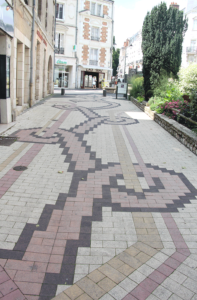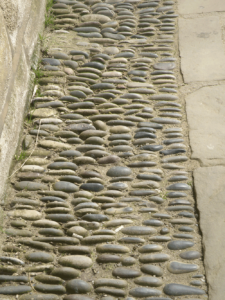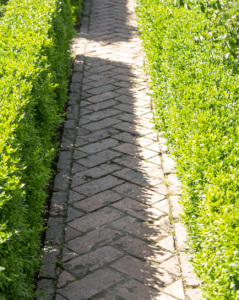With the vast range of possible paving materials, it can feel a bit daunting when you first start looking at paving materials. To try to reduce the selection down to a more manageable size, it is well to consider the practicalities imposed on you by what you are planning to use the paving for. You can then check how much of each type you are hoping to use, compare the costs of using different materials and if need adjust your plans.
Though there is considerable overlap; the uses for paving in a garden can be divided into four main categories: drives, patios, paths and utility areas.
Drives
When choosing a material for a drive the first consideration must be what will
happily withstand having a car regularly driven over it and parked on it. The second consideration, is that for many people it will be the first thing visitors see of their home though quiet a lot of the time most of it may be hidden under a car. How suitable a paving material for a drive will also be effected by how it is laid. No material if the base under it is too soft will support a car but materials like domestic 35mm paving flags, which would not normally support a car, may if laid onto concrete. Once you have eliminated the impractical options the choice comes down to cost and personal preference. Please note if you paving an area of your front garden planning permission may be needed.
Patios
Whereas a drive is something you park a car on, a patio can be a major feature of a garden and so your budget should try to reflect that. The important thing is that it forms an attractive feature and not a slab of paving. So break up the area by mixing different sizes of flags and/or using a mix of materials. You often see paving broken up with planting pockets; this is rarely successful with the plants getting stood on and heels and chair legs dropping down the planting pockets.
Paths
The idea of a garden path is as old as the garden itself, but a path has to have a purpose. And that will influence the materials used. If the path for instance, is going to be in a vegetable garden, where you are stepping on and off the path onto the bare soil you are going to have problems if you use gravel. Every time to step from one to the other soil and gravel will be transferred from one to the other; ending up with a muddy path you can’t clean. On the other hand, an informal path winding along the edge a border it is going to be difficult to achieve with square and rectangular flags and runs the risk of looking messy if its full of cut bits of flags.
Utility areas
Most gardens have some area dedicated to the necessary but unattractive bits of a garden where things such as the shed live. Here the importance has to be the functionality of the material. Something that is cheap, durable and easy to clean. A smooth flag is a lot easier to sweep clean than a riven one and a plain concrete slab, though unattractive, leaves few gaps for weeds to grow through.
Paving materials
The trick when designing your paving is to make it blend into the surrounds while adding to them. To do this you are free to use every trick in the book. You can use materials which contrast with their surrounding or complement them but care should be taken when trying to match materials as a bad match will be the worst scenario. Nor should you restrict yourself to just one material as mixing in an additional material is a very good way to break up areas of paving and differentiation between different areas. Just don’t overdo it!
Below I’ve put together a table of most of the paving/drive materials currently available, the list though is not exhaustive. The cost column is really only to give a very broad indication of the relative expense involved in using different ones The exact cost would depend on many factors including site conditions and how much if any of the work was undertaken on a DIY basis.
| Material | Cost | Advantages | Disadvantages |
|---|---|---|---|
| Bark | Low | Low cost Flexible Soft Water permeable Can look very effective in informal areas | Tends to spread about Needs edging |
| Gravel | Low | Low cost Flexible Comes in a very wide variety of colours and shapes Water permeable | Tends to move about Needs edging If too soft it will quickly disintegrate Only suitable for level areas |
| Plain concrete flags | Low | Low cost Readily available Provides a smooth surface Does not need pointing Good under sheds and for utility areas | Visually unattractive Very heavy |
| Coloured concrete flags | Low to medium | Low Cost Readily available Provides a smooth surface Do not need pointing | Visually unattractive Very heavy Colours fade – particularly reds |
| Budget riven flags | Low to medium | Low cost More attractive than plain flags Do not need pointing | Not as attractive as the more expense flags Limited range of colours and sizes Poor finish Limited range of patterns |
| Premium riven flags | Medium | Very wide range to choose from Large range of flags shapes and sizes | Can be as expensive as imported natural stone flags Care needed to ensure they are laid with the correct fall Limited life |
| Imported stone flags | Medium | Almost limitless life Very hard wearing Cost is equivalent to/or less than premium man-made flags | Needs a diamond blade to cut them Brittle so hard to work |
| Block paving | Medium to high | Very wide range of colours and patterns Very hard wearing Small size makes them very flexible | Must be securely edged Red ones fade Large areas can look like a car park even if it’s not Cannot be cleaned by pressure washing The surface must be 600mm above the water table |
| Stone setts | High | Hard to very hard wearing Small size makes them very flexible | Difficult to lay Need a very solid base Expensive Need to be pointed |
| New sandstone flags | High | Almost limitless life Natural product Very attractive | Heavy Expensive Requires skill to be laid well |
| Reclaimed sandstone flags | Very high | Almost limitless life Laid well are very attractive | Particularly prone to becoming slippery Very heavy Very expensive Require skill to lay them well |
| Mosaics | High to very high | Can look very attractive Unusual | Requires a lot of skill |
| Sandstone crazy paving | Medium | Flexible A cost effective alternative to sandstone flags | Needs skill to lay it well Can be hard to source |
| Tarmac | High | Makes an excellent hard-wearing surface Smooth Flexible Comes in a range of colours | Requires specialist skills to lay Only practical if sufficiently large area Must have a secure edging Limited range of colours Not very attractive |
| Cobble paving | High | Can look very good in the correct setting | Hard to source good worn cobbles Very uneven surface Prone to being slippery Requires a lot of skill to lay it well |
| Decking | Medium | Can be laid in a range of patterns Comes in a range of finishes Very good for levelling sloping sites Flexible | Prone to being slippery Limited life Requires more maintenance Needs to be lifted off the ground Any decking surface over 300mm above the ground level requires permission from your local authority |
| Concrete slab | Medium | Smooth Can be textured Laid well it is very durable Capable of supporting heavy loads Very good for utility areas | Requires skill to lay Large areas require good access Difficult to make good if it is damaged Large areas will crack if movement joints are built in |
| Pattern impressed concrete | Medium | Visually much better than plain concrete Can be laid in a range of patterns and colours | It is only a surface treatment so prone to surface damage Very difficult to make good if damaged The colour will wear away where car wheels repeatedly run over it Large areas will crack if movement joints are built in |
| Brick | High | Small units allow flexible designs Small their small sizes make them good for small areas | Bricks must be carefully chosen because of the risk of frost damage Skill required to lay |
| Reinforced grass | Medium | Provides a visually “soft” appearance Water permeable | Only really suitable for occasional car parking or footpaths |





